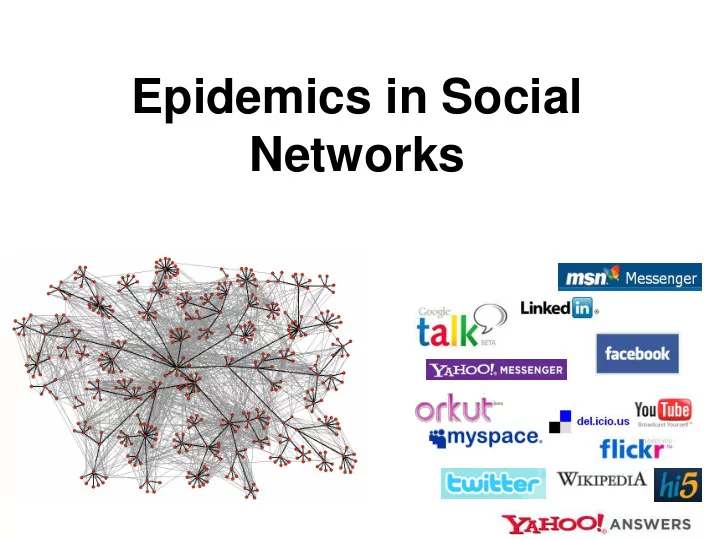

Epidemics in Social Networks
Epidemic Processes Epidemics, Influence, Propagation • Viruses, diseases • Online viruses, worms • Fashion • Adoption of technologies • Behavior • Ideas
Example: Ebola virus • First emerged in Zaire 1976 (now Democratic Republic of Kongo) • Very lethal: it can kill somebody within a few days • A small outbreak in 2000 • From 10/2000 – 12/2011 173 people died in African villages • 2012: Big outbreak worldwide, 11,314 deaths
Example: HIV • Less lethal than Ebola • Takes time to act, lots of time to infect • First appeared in the 70s • Initially confined in special groups: homosexual men, drug users, prostitutes • Eventually escaped to the entire population
Example: Melissa computer worm • Started on March 1999 • Infected MS Outlook users • The user – Receives email with a word document with a virus – Once opened, the virus sends itself to the first 50 users in the outlook address book • First detected on Friday, March 26 • On Monday had infected >100K computers
Example: Hotmail • Example of Viral Marketing: Hotmail.com • Jul 1996: Hotmail.com started service • Aug 1996: 20K subscribers • Dec 1996: 100K • Jan 1997: 1 million • Jul 1998: 12 million Bought by Microsoft for $400 million Marketing: At the end of each email sent there was a message to subscribe to Hotmail.com “Get your free email at Hotmail"
Example: Hotmail Hotmail Users 14000000 12000000 12M 10000000 8000000 6000000 4000000 2000000 1M 0 20K 100K 0 May-96 Dec-96 Jun-97 Jan-98 Jul-98 Feb-99
The Bass model • Introduced in the 60s to describe product adoption • Can be applied for viruses • No network structure • F(t): Ratio of infected at time t • p: Rate of infection by outside • q: Rate of contagion
The Bass model Explosive • F(t): Ratio of infected at time t phase • p: Rate of infection by outside Slow growth • q: Rate of contagion phase Burnout phase 1.0 0.8 0.6 0.4 0.2 0.2 0.4 0.6 0.8 1.0
Network Structure • The Bass model does not take into account network structure • Let’s see some examples
Example: Black Death (Plague) (Pestilenza) • Started in 1347 in a village in South Italy from a ship that arrived from China • Propagated through rats, etc. Dec 1350 Jun 1350 Dec 1349 Jun 1349 Dec 1348 Jun 1348 Dec 1347
Example: Mad-cow disease • Jan. 2001: First cases observed in UK • Feb. 2001: 43 farms infected • Sep. 2001: 9000 farms infected • Measures to stop: Banned movement, killed millions of animals
Example: H1N1 http://www.youtube.com/watch?v=tWKdSQilFj4
Example: H1N1 14000 12000 10000 8000 6000 4000 2000 0 22-Apr 27-Apr 2-May 7-May 12-May 17-May 22-May 27-May
Network Impact • In the case of the plague it moves on the plain • In the mad cow we have weak ties, so we have a small world – Animals being bought and sold – Soil from tourists, etc. • To protect: – Make contagion harder – Remove weak ties (e.g., mad cows, HIV)
Example: Join an online group
Example: Publish in a conference
Example: Adopt a technology 0.40000% Probability of Premium Adoption 0.35000% 0.30000% 0.25000% 0.20000% 0.15000% 0.10000% 0.05000% 0.00000% 0 1 2 3 4 5 6 7 8 9 # Premium Friends
Example: obesity study Christakis and Fowler, “The Spread of Obesity in a Large Social Network over 32 Years”, New England Journal of Medicine, 2007. • Data set of 12,067 people from 1971 to 2003 as part of Framingham Heart Study • Results – Having an obese friend increases chance of obesity by 57%. – obese sibling ! 40%, obese spouse ! 37% • Methodology – Logistic regression, taking many attributes into account (e.g., age, sex, education level, smoking cessation) – Taking advantage of data that is available over time – “edge - reversal test”
Obesity study
Obesity study
Example: Use the same tag
Modeling Approaches Two main types of mathematical models Game theoretic • Users are rational players in a “game” • Answer why Probabilistic • There is a random process that governs the user actions • Allow fitting the model to data to estimate parameters • Can be used to make predictions • Answer how
Models of Influence • We saw that often decision is correlated with the number/fraction of friends • This suggests that there might be influence: the more the number of friends, the higher the influence • Models to capture that behavior: – Linear threshold model – Independent cascade model
Independent Cascade Model • We have a weighted directed graph with weight p uv on edge (u,v). 0.6 0.2 0.2 0.3 • When node u becomes active, it has a single chance of X U 0.1 0.4 activating each currently inactive neighbor v. 0.5 0.3 0.2 0.5 w • The activation attempt v succeeds with probability p uv .
Example 0.6 Inactive Node 0.2 0.2 0.3 Active Node Newly active X U 0.1 node 0.4 Successful attempt 0.5 0.3 0.2 Unsuccessful attempt 0.5 w v Stop!
Linear Threshold Model • A node u has threshold θ u • A node v is influenced by each neighbor u according to a weight b uv such that • A node v becomes active when at least (weighted) θ v fraction of its neighbors are active Examples: riots, WIND / TIM
Example Inactive Node 0.6 Active Node Threshold 0.2 0.2 0.3 Active neighbors X 0.1 0.4 U 0.3 0.5 Stop! 0.2 0.5 w v
Optimization problems • Given a particular model, there are some natural optimization problems. 1. How do I select a set of users to give coupons to in order to maximize the total number of users infected? 2. How do I select a set of people to vaccinate in order to minimize influence/infection? 3. If I have some sensors, where do I place them to detect an epidemic ASAP?
Recommend
More recommend